
We’re excited to announce a major expansion to the Embrace platform: the launch of Real User Monitoring (RUM) for Web. Powered by OpenTelemetry, this new product extends the granular data collection of Embrace’s SDKs and robust analytical capabilities of the Embrace dashboard to websites and web apps.
In this post, we’ll cover how Embrace Web RUM solves a challenge faced by our customers, and by engineering teams across industries: the ability to truly understand how end users experience their applications, regardless of the screen.










